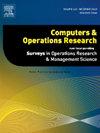Soft happy colourings and community structure of networks
IF 4.1
2区 工程技术
Q2 COMPUTER SCIENCE, INTERDISCIPLINARY APPLICATIONS
引用次数: 0
Abstract
For , a -happy vertex in a coloured graph has at least same-colour neighbours, and a -happy colouring (aka soft happy colouring) of is a vertex colouring that makes all the vertices -happy. A community is a subgraph whose vertices are more adjacent to themselves than the rest of the vertices. Graphs with community structures can be modelled by random graph models such as the stochastic block model (SBM). In this paper, we present several theorems showing that both of these notions are related, with numerous real-world applications. We show that, with high probability, communities of graphs in the stochastic block model induce -happy colouring on all vertices if certain conditions on the model parameters are satisfied. Moreover, a probabilistic threshold on is derived so that communities of a graph in the SBM induce a -happy colouring. Furthermore, the asymptotic behaviour of -happy colouring induced by the graph’s communities is discussed when is less than a threshold. We develop heuristic polynomial-time algorithms for soft happy colouring that often correlate with the graphs’ community structure. Finally, we present an experimental evaluation to compare the performance of the proposed algorithms thereby demonstrating the validity of the theoretical results.
网络的软快乐色彩和群落结构
对于 0<ρ≤1,彩色图 G 中的ρ-快乐顶点 v 至少有ρ⋅deg(v) 个同色相邻顶点,G 的ρ-快乐着色(又称软快乐着色)是使所有顶点都ρ-快乐的顶点着色。社群是一个子图,其顶点之间的相邻关系多于其他顶点之间的相邻关系。具有群落结构的图可以用随机图模型来建模,如随机块模型(SBM)。在本文中,我们提出了几个定理,说明这两个概念是相关的,并在现实世界中有着大量应用。我们证明,如果模型参数的某些条件得到满足,随机块模型中的图群落很有可能会在所有顶点上诱发 ρ 快乐着色。此外,还推导出了ρ的概率阈值,从而使随机块模型中的图群落诱发ρ-快乐着色。此外,我们还讨论了当 ρ 小于阈值时,图的群落诱导的 ρ 快乐着色的渐近行为。我们为软快乐着色开发了启发式多项式时间算法,这种算法通常与图的群落结构相关。最后,我们通过实验评估来比较所提算法的性能,从而证明理论结果的正确性。
本文章由计算机程序翻译,如有差异,请以英文原文为准。
求助全文
约1分钟内获得全文
求助全文
来源期刊

Computers & Operations Research
工程技术-工程:工业
CiteScore
8.60
自引率
8.70%
发文量
292
审稿时长
8.5 months
期刊介绍:
Operations research and computers meet in a large number of scientific fields, many of which are of vital current concern to our troubled society. These include, among others, ecology, transportation, safety, reliability, urban planning, economics, inventory control, investment strategy and logistics (including reverse logistics). Computers & Operations Research provides an international forum for the application of computers and operations research techniques to problems in these and related fields.
 求助内容:
求助内容: 应助结果提醒方式:
应助结果提醒方式:


